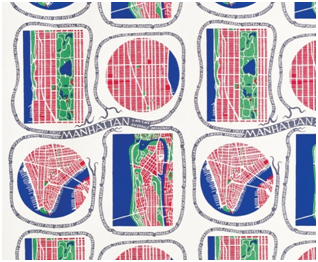
- Hechos
El asunto tiene por objeto dirimir una cuestión prejudicial planteada por el Tribunal de Apelación de Estocolmo en el marco de un pleito surgido entre Svenkt Tenn AB, por un lado, y Textilis Ltd y el Sr. Ozgur Keskin, por otro, a causa de la comercialización por parte de estos últimos de objetos de decoración de interiores que incluían diseños similares a los de la siguiente marca de la compañía Svenkt Tenn AB:
El origen del conflicto litigioso comenzó con la interposición por parte de la compañía Svenkt Tenn de dos demandas, una por violación de la marca señalada y otra por infracción de los derechos de propiedad intelectual que recaían sobre el diseño de esta misma marca. Frente a estas demandas, Textilis Ltd y el Sr. Ozgur Keskin reconvinieron solicitando la nulidad de la marca MANHATTAN por tratarse, a su juicio, de un signo no distintivo y conformado exclusivamente por la forma que aporta un valor sustancial al producto, conforme al artículo 7.1.e).iii). del Reglamento (CE) nº207/2009 sobre la marca comunitaria.
El tribunal de primera instancia estimó las demandas por violación de marcas y por infracción de derechos de propiedad industrial interpuestas por Svenskt Tenn, desestimando la reconvención. Los demandados-reconvinientes recurrieron en apelación insistiendo en la nulidad de la marca MANHATTAN por estar, a su juicio, constituida exclusivamente por una forma que aporta un valor sustancial al producto.
En el anterior contexto, y al cuestionarse la validez de esta marca, el tribunal de apelación planteó una cuestión prejudicial en relación con la interpretación del artículo 7.1.e).iii). del citado Reglamento (CE) nº207/2009.
En concreto, el órgano jurisdiccional remitente pregunta si debe entenderse que un signo constituido por un diseño bidimensional decorativo, como la marca MANHATTAN, está constituido exclusivamente por la forma cuando se aplica a productos bidimensionales como una tela o un papel, convirtiéndose en el elemento esencial del propio producto.
- Pronunciamientos
Para resolver la consulta planteada, el Tribunal revisa la jurisprudencia aplicada hasta el momento y en particular su Sentencia de 12 de junio de 2018, Louboutin y Christian Louboutin, C-163/16, donde se vino a establecer que la forma es un “conjunto de líneas o de contornos que delimitan el producto de que se trate en el espacio”, para sostener que la afamada marca de la suela roja de Louboutin no consiste en una forma, sino en la aplicación de un color a un determinado lugar específico de un producto, por lo que no se protege la forma de la suela, sino la aplicación del color a dicha parte específica.
Trasladando el razonamiento empleado en la Sentencia Louboutin al presente caso, el Tribunal de Justicia concluye que no procede aplicar la prohibición del artículo 7.1.e).iii) del Reglamento (CE) nº207/2009 ya que no puede considerarse que un signo que consiste en un diseño bidimensional decorativo no se distingue de los productos sobre los que se coloca, aunque se trate de una tela papel igualmente bidimensional.
- Comentario
El Tribunal de Justicia ahonda en la necesidad de distinguir entre continente, o forma, y contenido, o representación de una marca, concluyendo que no es aplicable el artículo 7.1.e).iii). del Reglamento (CE) nº207/2009 a aquellos signos cuya representación no se confunde con la forma del producto sobre el que se colocan.
Ahora bien, procede recordar que la versión modificada del artículo 7.1.e).iii). del vigente Reglamento 2015/2424 del Parlamento Europeo y del Consejo, de 16 de diciembre de 2015, prohíbe el acceso al registro de los signos constituidos exclusivamente por la forma u otra característica que aporte un valor sustancial al producto, por lo que habrá que esperar hasta conocer qué entiende el TJ por “otra característica” para ver si procede revisar la aplicabilidad de esta prohibición a casos análogos al de Manhattan o Louboutin.
Lo que está claro es que, sea cual sea la postura que en su momento adopte el alto tribunal, la clave a la hora de discutir la validez de una marca no convencional, como la marca MANHATTAN –que a mi juicio sería más una marca patrón que una marca figurativa– no será tanto dilucidar si consiste exclusivamente o no en la forma u otra característica que aporte un valor sustancial al producto, sino en verificar si es capaz de cumplir con la función básica de la marca; esto es, denotar, para el público consumidor destinatario, un origen empresarial concreto.
Autor: Cristina VELASCO. Anuario Elzaburu, Edición 2019 (recopilatorio de comentarios de jurisprudencia europea en materia de Derecho de Propiedad Industrial e Intelectual que realiza Elzaburu).
Acceso al documento de la Sentencia del TJUE de 14 de marzo 2019 proveniente de la base de datos NEO. Más información y posibilidad de probar gratuitamente el producto en https://www.efl.es/catalogo/bases-de-datos-juridicas-neo
Versión en inglés:
Trademarks consisting of decorative designs are not indistinguishable from the shape of the goods to which they are affixed. Judgment of the Court of Justice of 14 March 2019, Manhattan (C-21/18).
- Background
The case concerns a request for a preliminary ruling made by the Court of Appeal in Stockholm, Sweden, in the context of proceedings involving Svenkt Tenn AB, on the one hand, and Textilis Ltd and Mr. Ozgur Keskin, on the other, in relation to the sale by the latter parties of interior decoration articles which included designs similar to those of the following trademark owned by the company Svenkt Tenn AB:
The dispute originated with two actions brought by the company Svenkt Tenn, one for infringement of the aforementioned trademark and another for infringement of the copyright in the design of that same trademark. Textilis Ltd and Mr. Ozgur Keskin brought a counterclaim, seeking a declaration of invalidity of the MANHATTAN trademark, given that, in their view, it is a non-distinctive sign consisting exclusively of a shape which gives substantial value to the goods, within the meaning of Article 7(1)(e)(iii) of Regulation (EC) No. 207/2009 on the Community trademark.
The first instance court (Stockholm District Court) upheld the actions for trademark infringement and copyrighrt infringement brought by Svenkst Tenn, dismissing the counterclaim. Textilis Ltd and Mr. Keskin appealed against that judgment, again seeking a declaration that the MANHATTAN trademark is invalid, in that, in their view, it consists exclusively of a shape which gives substantial value to the goods.
In the light of the above and with the validity of this trademark having been brought into question, the Court of Appeal submitted a request for a preliminary ruling in relation to the interpretation of Article 7(1)(e)(iii) of Regulation (EC) No. 207/2009.
Specifically, the referring court asks whether it is to be understood that a sign consisting of a two-dimensional decorative design, such as the MANHATTAN trademark, is made up exclusively of the shape when applied to two-dimensional goods such as fabric or paper, thereby becoming a key feature of the goods themselves.
- Findings.
In order to respond to the question referred for a preliminary ruling, the Court reviews the case law applied to date and, in particular, its judgment of 12 June 2018, Louboutin and Christian Louboutin, C-163/16, in which it was established that the concept of ‘shape’ is understood to be a “set of lines or contours that outline the product concerned”, and it was thus held that Louboutin’s famous red sole trademark does not consist of a shape but of the application of a colour to a specific part of a product, and therefore it does not protect the form of the sole but rather the application of the colour to that specific part.
Applying the reasoning followed in the Louboutin judgment to the case at hand, the Court of Justice concludes that Article 7(1)(e)(iii) of Regulation (CE) No. 207/2009 is not applicable, given that it cannot be held that a sign which consists of a two-dimensional decorative design is indistinguishable from the goods to which it is affixed, even if the goods in question are a likewise two-dimensional fabric.
3. Remarks.
The Court of Justice explores the need to distinguish between the content or representation of a trademark and the product or shape to which it is applied, concluding that Article 7(1)(e)(iii) of Regulation (EC) No. 207/2009 does not apply to those signs whose representation is distinguishable from the shape of the goods to which they are affixed.
However, it is important to note that the amended version of Article 7(1)(e)(iii) under Regulation No. 2015/2024 of the European Parliament and of the Council of 16 December 2015, currently in force, prohibits the registration of signs consisting exclusively of the shape, or another characteristic, which gives substantial value to the goods. Therefore, we will have to wait until we know what the Court of Justice understands by “another characteristic” to see whether it will be appropriate to review the applicability of this bar to registration in cases similar to the Manhattan or Louboutin cases.
What is clear is that, whatever the position ultimately adopted by the Court of Justice, the key when assessing the validity of a non-conventional trademark, such as the MANHATTAN trademark (which in my view would be more a pattern mark than a figurative mark), will not so much be to determine whether or not it consists exclusively of the shape or another characteristic which gives substantial value to the goods, but to establish whether it is capable of performing the basic function of a trademark, that is, to identify a specific business origin for consumers. Cristina VELASCO.
ElDerecho.com no comparte necesariamente ni se responsabiliza de las opiniones expresadas por los autores o colaboradores de esta publicación









